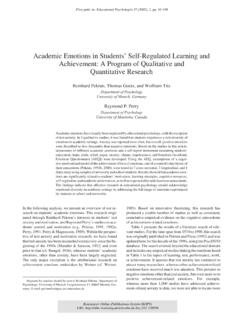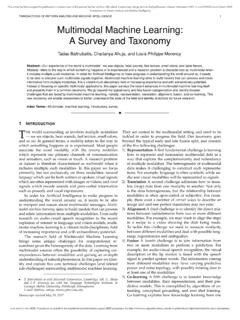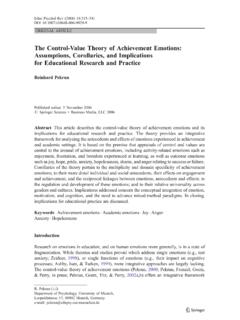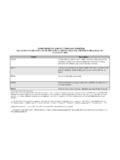Transcription of Expressing emotion through posture and gesture
1 Expressing emotion through posture and gesture Introduction emotion and its physical expression are an integral part of social interaction, informing others about how we are feeling and affecting social outcomes (Vosk, Forehand, and Figueroa 1983). Studies on the physical expression of emotion can be traced back to the 19th century with Darwin s seminal book1 The Expression of the emotions in Man and Animals that reveals the key role of facial expressions and body movement in communicating status and emotion (Darwin 1872). While emotions can be expressed through different modalities, facial expressions have been the most extensively studied. A smile can convey pleasure and agreement, a raise of eyebrow skepticism and clenched teeth cold anger. More than 95 per cent of the literature on emotion in humans has used faces as stimuli, at the expense of other modalities (Gelder 2009).
2 Less studied are the ways our body also conveys emotional information, such as adopting a collapsed posture when depressed or leaning forward to show interest. Indeed, our interest here is this less extensively studied field of bodily expression of emotion that models how people communicate emotion through body posture and gesture , and how people make inferences about someone else s emotional state based on perceived posture and gesture . In addition to furthering basic understanding of human behavior, work on the bodily expression of emotion has played a key role in research on Embodied Conversational Agents (ECAs; Cassell 2000), also known as Virtual Humans (Rickel et al., 2001). ECAs are animated characters capable of social interaction with people through dialogue and nonverbal behaviors, using the same modalities such as voice, facial expression, postural shifts and gestures that people use in face-to-face interaction.
3 1 Darwin was strongly influenced by the work of a French anatomist, Pierre Gratiolet who explored body language shared by men and animals. Unfortunately, Gratiolet s work remains largely unknown since his book has never been translated into English (Gratiolet 1865). Given emotion s role in human social interaction, it is not surprising that research in ECAs has sought to endow them with the ability to employ emotion and emotional expression. A computational model of the relation between emotion and its bodily expression can serve several roles in the design of ECAs. For one, it can guide the recognition of the emotional state of the user (see Chapter 15). This chapter focuses on another role, the generation of appropriate bodily expression for ECAs.
4 One of the fundamental questions in studying bodily expression has been what aspects of emotion are expressed through the various physical behaviors and additionally what do observers reliably infer from such behaviors. Specifically, there has been considerable debate as to whether posture and movement reliably convey emotion categories or rather, consistent with a dimensional view, convey the intensity of emotion (see Paul Ekman 1965; Paul Ekman and Friesen 1967 for a discussion of this point). A related question arises as to which features of the bodily movement are relevant to inferences of emotion . These features might concern the form of the movement or posture , the quantity of movement or the dynamics of the motion. In this chapter, we discuss the methodological issues that arise in studying the bodily expression of emotion and the solutions that have been proposed.
5 Then, we present a review of which features seem to be specific to certain emotions or to certain properties of emotion (such as intensity) according to several psychological studies. The last section describes the computational models of bodily expression that have been designed for virtual humans, most particularly Embodied Conversational Agents, to perform postures and gestures that reflect their emotional state. Issues in the study of emotion expression in posture , movement and gesture The study of the bodily expression of emotions faces several theoretical and methodological challenges, ranging across fundamental theoretical questions about how emotions are defined and how emotional expressions are represented, experimental issues concerning how emotional expressions are invoked in subjects and design issues concerning the goals of the ECA designer in using emotional expressions.
6 Encoding and decoding One of the central issues impacting the study of emotional expression concerns the distinction between a person s encoding of emotion in physical behavior versus an observer s decoding of emotion from observations of the person s behavior. How emotion is encoded in nonverbal behavior can differ from how it is decoded (See Gifford, 1994 for a related work on personality and nonverbal behavior). This discrepancy leads to several theoretical and methodological issues. As we discuss below, studies of human expression of emotion have often used actors to create stimuli for experiments. However, actors, depending on how their training and approach to acting, may be more concerned with how an audience decodes a behavior as opposed to a naturalistic encoding. Regardless, intentionally realizing a natural performance is difficult at best and impossible in some cases, leading to differences in dynamics of the motion, timing and symmetry.
7 Further, there is also the related question of whether expressive behavior reflects an underlying emotional state (Paul Ekman and Friesen 1967) as opposed to the view that expressive behaviors only serve to as intentional signals aimed at influencing other s behaviors (Fridlund 1991; Fridlund 1997). These issues touch upon the intentions of the designer of the ECA, who must address both whether naturalistic encoding versus ease of decoding is the design goal as well as whether emotion is conveying underlying emotion of the ECA and/or is being used as explicit social signal. Representation of posture , movement and gesture Foremost is the absence of a standard that codifies which are the features under study, including what are the components of the movement and how their dynamics are specified. In contrast, the work on facial expressions has relied on an agreed upon standard, the Facial Action Coding System (FACS;(Paul Ekman, Friesen, and Hager 1978; Paul Ekman, Friesen, and Hager 2002)).
8 Such a system facilitates the coding of observed behaviors as well as the design of stimuli for experiments. In the absence of an agreed upon standard, researchers must answer the question of how to represent the parts of the body that are involved, the dynamics of the movement and the form of the movement. We describe in the following some of the coding systems that have been used to study the bodily expression of emotion . Representing posture and body-parts position posture usually refers to the quasi-static configuration of the whole body. Seating, standing and lying can be considered as three postures (Argyle 1975), but this description is too restrictive to study the effect of emotion . posture is usually defined by the position and orientation of specific body parts. Orientation can be relative.
9 For example, (Mehrabian 1972) uses a few global descriptors such as relative orientation to the partner, closeness or openness and symmetry of body limb. (Harrigan 2005) reports that posture coding systems use the following common descriptors: trunk lean (upright, forward or backward), trunk orientation (facing, turned), arms and leg positions and configurations ( hands in pockets, legs crossed). Absolute orientation values are described regarding the sagittal, frontal and transverse axis of the body ( (Gross, Crane, and Fredrickson 2012)). Representing movement Early studies on body movement manually detailed the position of each body part over time (Birdwhistell 1970; Frey and Pool 1976). Such an approach is tedious and time-consuming, so researchers looked for ideas from other disciplines.
10 Choreographers describe the body movement preserve and transmit a dance score to dancers. In particular, Rudolf Laban, his students and colleagues have developed several frameworks to represent movement. The Laban Movement Analysis described the actions of the body parts over time by using a notation system composed of symbols that represent the quantitative and qualitative features of movements. Symbols are organized into five categories: Body (parts of the body involved), Space (locale, directions and path of a movement), Effort (how the body performs movements) and Shape (forms that the body makes in space). The Effort-Shape analysis (Dell 1977) derives from Laban and only focuses on the effort and shape dimensions. Representing gesture All gestures are movements, but not all movements are gestures.










